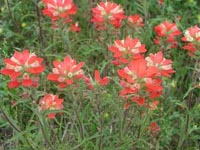Resource Library
Plant of the Week: Paintbrush, Indian
The University of Arkansas System Division of Agriculture does not promote, support or recommend plants featured in "Plant of the Week." Please consult your local Extension office for plants suitable for your region.
Plant of the Week
Indian Paintbrush
Latin: Castilleja coccinea

Growing wildflowers along a roadway is a tricky business. Being native plants, logic tells you it should be easy, but such is hardly the case.
But thanks to Mother Nature and a helping hand of the state highway department, the Arkansas roadside wildflower flora is colorful, abundant and becoming more diverse each year. A plant that has gained a foothold along our interstate system in recent years is Indian Paintbrush, Castilleja coccinea.
Indian Paintbrush is what botanists call a "scroph," a member of the same family as foxglove and snapdragon. Like foxglove, Indian Paintbrush is a biennial. The first year it grows as a small rosette inconspicuously nestled amongst the grass and weeds.
The spring of its second year it shoots skyward on a leafy 18- inch, unbranched spike topped with an orange or scarlet flowers. After flowering and subsequent seed set, the original plant dies.
The true flowers are small and inconspicuous with the showy portion hairy, inch long bracts. The flowers are clustered atop of the slender stem and, if you’re blessed with a good imagination or have been drinking, look somewhat like an artist’s paintbrush.
Castilleja coccinea is the most common of the 200 species found in the Americas, ranging from the New England states to north-central Texas.
What makes Indian Paintbrush noteworthy as a wildflower is that botanists consider it a hemiparasite. It develops haustoria on its roots, a kind of coupling that allows it to attach to nearby plants and siphon off mineral nutrients and water. The literature is full of inconsistencies about exactly what makes a good host plant for this parasite, for apparently any number of herbaceous and woody plants will work. Oxeye daisy is a commonly mentioned host plant with a similar growth habit, blooming time and environmental requirement.
The establishment of sustainable populations of Indian Paintbrush along the roadways begins with fall planting. The seeds require a two-month cold treatment to satisfy the dormancy requirement, hence germination usually does not occur until the soil warms in early spring. If a suitable host plant is nearby, the plant will affix itself and produce its flowers a year later.
Because erosion control is a paramount concern in roadway construction, grass cover must be established first. Once the grass is established and erosion controlled, it becomes more difficult for wildflowers to gain foothold along the roadside. If the site is moist and sunny and a suitable host plant population exists, a self-sustaining community of Indian Paintbrush grows.
The Arkansas Department of Transportation maintains a modest wildflower planting program and tries to manage mowing cycles to assure that wildflower plantings are allowed to reach a mature stage of seed development before the mowers move in. Many motorists are apparently unaware of the need for time for seed crops to mature, for one of the most frequently heard complaints by the agency is that the roads look shaggy and should be mowed. Communities or organizations interested in wildflower planting projects can purchase seeds and the DOT will plant them in appropriate areas.
Growing Indian Paintbrush in the garden is difficult at best. Plants cannot be transplanted, so they must be seeded where they will be grown. Seeds are commercially available from wildflower seed producers and from the seed exchange list of the North American Rock Garden Society.
A couple of Pacific Northwest gardeners tell of growing a dozen or more species in their gardens, but most who have tried find it difficult to establish and maintain under cultivation.
By: Gerald Klingaman, retired
Extension Horticulturist - Ornamentals
Extension News - May 16, 2003
The University of Arkansas System Division of Agriculture does not maintain lists of retail outlets where these plants can be purchased. Please check your local nursery or other retail outlets to ask about the availability of these plants for your growing area.